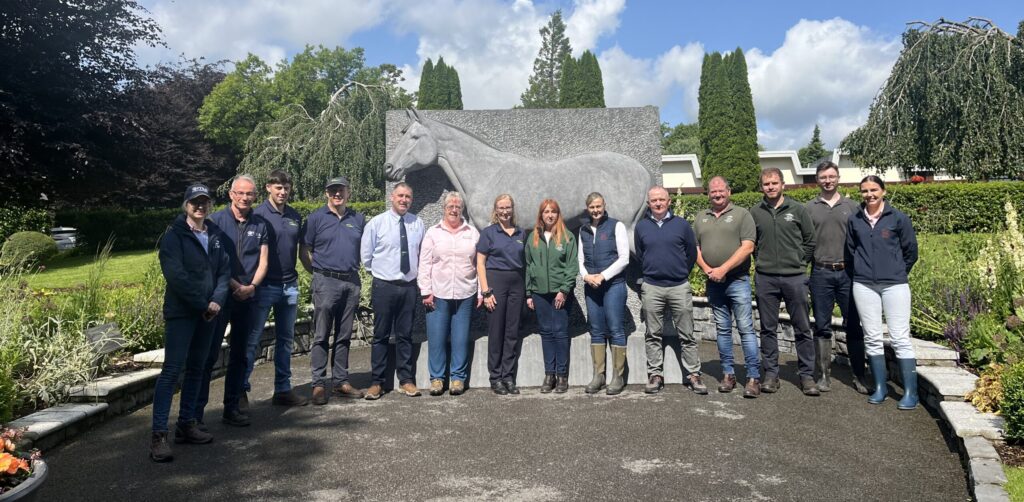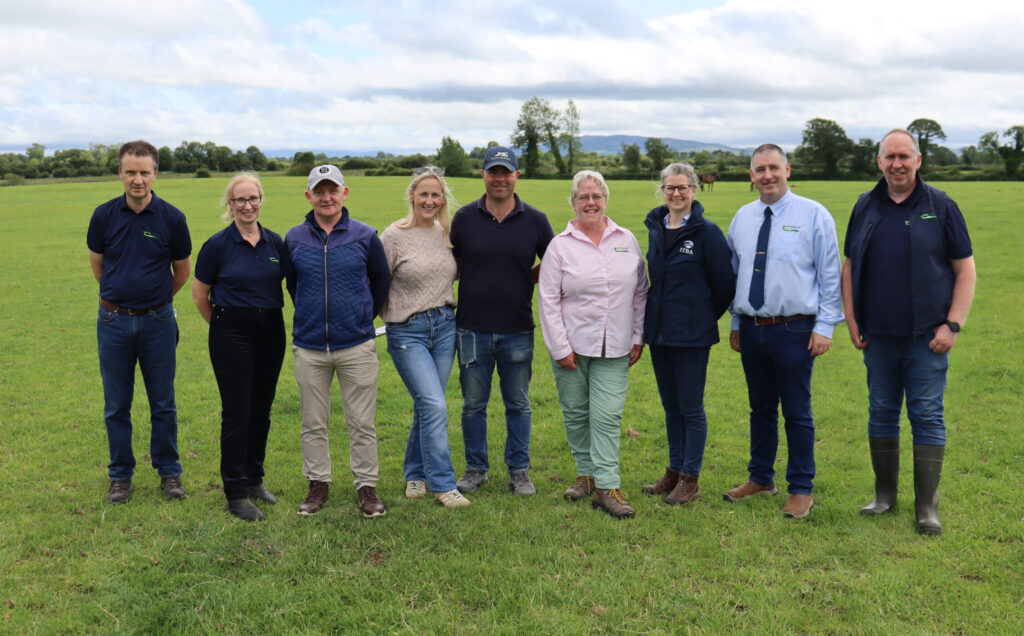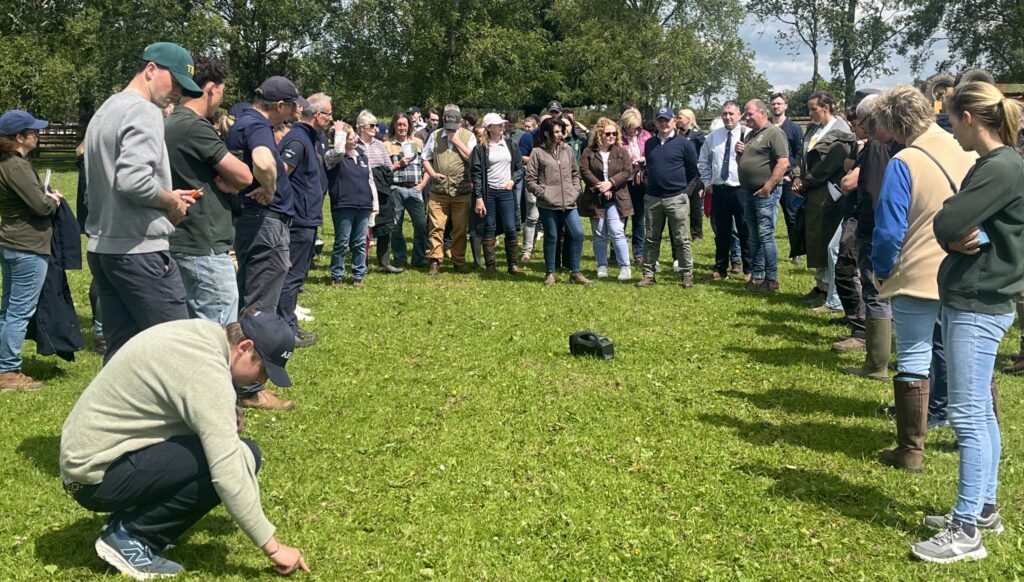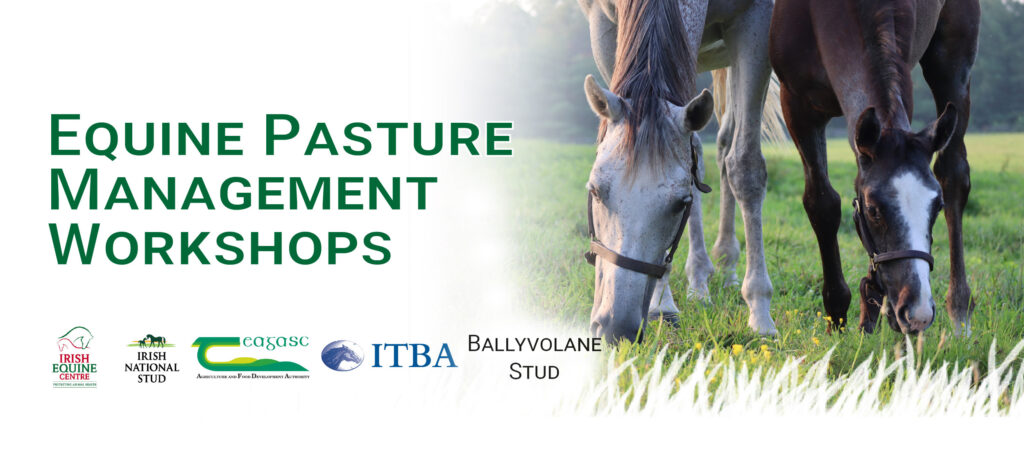Equine Pasture Management Workshops 2025
Teagasc and the Irish Equine Centre, in collaboration with the ITBA, held two very successful workshops in June 2025 on Equine Pasture Management. The workshops focused on efficient farming, pasture management, soil management, pasture hygiene, water quality, and biodiversity on equine farms. We would like to thank all specialists involved and the stud farm hosts, Irish National Stud and Ballyvolane Stud.
Speakers included Alan Creighton, Head of Environment and Nutrition at the Irish Equine Centre, with Catherine Keena, Teagasc Countryside Management Specialist; Mark Plunkett, Teagasc Signpost Programme and Soils Specialist; Pádraig Fitzgerald and Joseph Maher, Water Quality Advisors, Teagasc ASSAP Programme; and Kevin O’Sullivan, Teagasc advisor. The events were facilitated by Teagasc Equine Specialists Seán Keane, and Wendy Conlon.

The first of the Equine Pasture Management Workshops took place on Friday, 13 June in the Irish National Stud. Pictured at the event are (l-r): Hannah Marks and Peter O’Reilly, Irish Thoroughbred Breeders Association; Joseph Maher, Mark Plunkett, Seán Keane, Catherine Keena and Wendy Conlon, Teagasc; Anne Channon, The Irish National Stud; Debbie Grey, and Alan Creighton, The Irish Equine Centre; Colin Barrett and James O’ Brien, Irish National Stud; and David Harney and Orla Murphy.
Key takeaways
Grassland and grazing plan
Think months instead of weeks ahead to get the most value from available pasture. In making a plan, it is critical that it is underpinned by soil analysis information, and an understanding of the type of soil and any relevant issues such as compaction or drainage problems for example. A garden spade is a useful tool to dig test profiles in paddocks and see what is happening underneath the grass sod.
It is also cost beneficial to soil test as the information gained ensures calculations can be made to add only the quantity of lime and fertiliser needed, and in the right places.
Soil fertility and structure
Focus on managing the soil well, to in turn produce good grass.
The main pillars of good grassland and soil health are pH, phosphorous(P) and potassium(K) indices, and organic matter content (top 10% of soil),
- Taking good soil samples is a key starting point to develop a good picture of the soil nutrient status on your farm.
- Then, first correct the soil pH (optimal pH is 6.3-6.5 for mineral soils or 5.5-5.8 for peat soils) as this governs the availability of other nutrients. Correcting pH, liming as required, is the most cost-effective measure to grow more grass. The objective is to reach a maintenance position where nutrients and lime only need to be topped up as required.
- While soil index 3 for P and K may be an objective for those saving hay or haylage, for many achieving high index 2 is sufficient to maintain grazing horses without providing over-lush pasture, particularly with growing youngstock in mind.
- Soil aeration to reduce compaction, improve worm activity, and in turn movement of air, water, and nutrients throughout the soil whilst also providing a safer turf for young and growing stock to exercise on, is another critical management task.
Stocking density
Stocking density is a very important consideration driving management decisions.
High stocking density (greater than 1.5 horses per hectare) can have negative impacts, most particularly with availability of adequate grass, potential exposure of soil and likely associated weed encroachment, also excessive latrine areas which are left ungrazed can become a problem. Excessive use of paddocks increases the likelihood of issues such as compaction and poaching.
In contrast low stocking densities can result in an over supply of grass which needs to be managed either by introducing additional livestock, topping, or closing areas off for forage conservation.
Mixed grazing with other livestock has benefits not only for parasite management but also in maintaining a more event sward overall, and more palatable grazing. Sheep or cattle can be grazed after horses to help manage un-grazed areas of paddocks. Cattle are more likely to graze longer grass and can sometimes be followed by horses. However, caution is needed if high fertiliser inputs are used to maintain cattle, as this could pose health risks to horses.
Organic manures
Organic manures are a valuable source of N, P and K and can effectively replace artificial fertilisers. Well-rotted farmyard manure (FYM) can be used on grass for horses. It has the advantage that it releases nutrients over a longer period than chemical fertilisers. It is also important to consider whether there is any anthelmintic resistance on the farm (in which case all FYM should be exported). Using FYM on the land has the additional benefit of improving organic matter content in the soil.

Reseeding versus overseeding
Upgrading an existing pasture should begin by addressing any compaction or drainage problems, and tackling any existing weed problems. New seeds can be added to an existing sward but they must be able to compete with the existing older grasses already there. While problems such as poached soils are undesirable an opportunity presents to re-seed or over-seed with palatable, and more sustainable grass varieties.
Re-seeding paddocks for horses should only be considered when absolutely necessary and should not be looked upon as the only way of improving a paddock as it takes three to four years for the root structure and turf consistency to stabilise following plough and reseed. Minimum tillage (till) or no tillage (till) options might be better to consider, to minimises soil disruption, and maintain the turf stability and cushion while stitching in palatable and turf-forming grass varieties. Also specific areas of a paddock can be targeted, such as gateways and heavily stocked areas.
Equine health at pasture
How grassland is managed can impact herd health. Bacteria like Clostridia and Rhodococcus equi prosper in conditions where there is much bare soil. Paddocks which are over-used, over-stocked, badly poached, with poor drainage and poor grass cover are likely to be havens for disease causing microorganisms.
Consider also the positioning of gateways, feed troughs, and water troughs that these are positioned where they are least likely to result in water-logged soil. Consider using deep-rooting grasses like timothy which will help keep soil structure together. Certain herbs like yarrow and plantain are also deep rooting and assist with maintaining soil structure.
Assess what parts of the farm you’re going to use in summer months and winter months and use appropriate seed mixes for each.
It is very important to aerate highly compacted and high traffic soil. Fertilise, overseed, ring roll and rest these paddocks to allow for growth. Sheep are ideal cross grazers as they will increase soil density and clean up the sward.

Biodiversity
Making space for native flora and fauna to thrive on the farm is a gift to biodiversity, including the flora and fauna on your farm.
But, not all species contribute positively to biodiversity. Be aware of
- ‘invasive alien’ plants: these compete with the native growing plants. Avoid the ‘wild flower mixes’ as they can contain invasive species and don’t last as long as native species
- Ornamental species: these are best retained in the garden, not at pasture
- Introduced species are not as in-tune with the native Irish climate and environment. Grants only apply to native species.
- Noxious weeds including ragwort, docks and thistle should be prevented from establishing.
- Field margins and corners of fields or less productive areas are opportune places to ‘give back to nature’. These strips of land on the edge of fields can act as corridors for wildlife movement and a space for a diverse range of plants, including wildflowers, grasses, and other native species which also support various insects, pollinators, birds, and small mammals. Maintaining or creating field margins is an effective way for farmers to contribute to biodiversity conservation, especially with the support of agri-environmental schemes like ACRES.
- Every farm should have some escaped and some topped hedges, both with different biodiversity values. Ideally allow some whitethorn trees to grow to maturity in topped hedges providing flowers and fruit.
Water quality
Water is a key resource which can be affected by how you manage your farm. Check if your farm is in a nitrogen or phosphorous rich area on www.catchments.ie as this may affect the management of nutrient application on the farm. If there is a water course on the farm consider the riparian zones (buffer zones next to the water course) which should not be accessible by animals, sprayed, or fertilised.
Having the water supply on the farm tested frequently is a good practice to understand if there are deficient or harmful levels of minerals which can affect the animals drinking it. For example, where high iron levels are present putting filters on taps is a proactive step to take. Water being provided from a well on the farm may benefit from UV filter which can breakdown certain bacteria. Filters need to be maintained and changed.
Different Schemes available
- IEC testing packages
- Farming for Water EIP – Measures
- Department of Agriculture, Food and the Marine – Echo-scheme
- Department of Agriculture, Food and the Marine – ACRES

